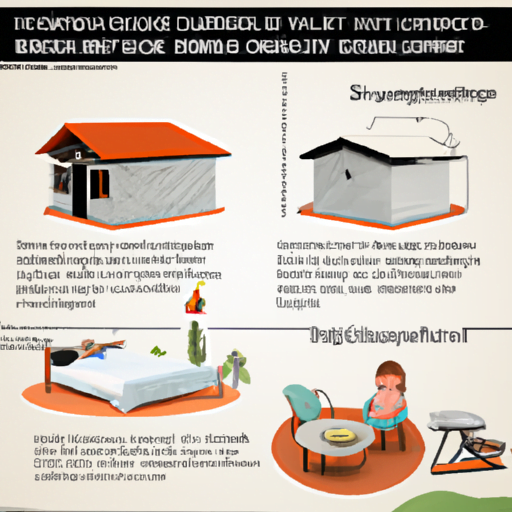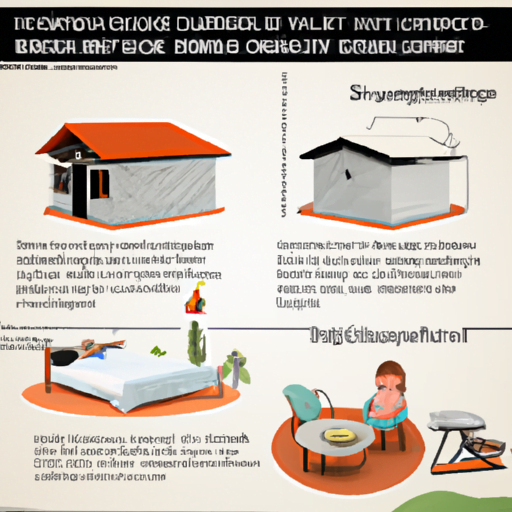Have you ever wondered what it’s like to live in a tiny house? You know, those cute little homes on wheels that seem to be popping up everywhere. Well, get ready, because we’re about to delve into the fascinating world of tiny house living. In this article, we’ll be exploring the boundaries of tiny house living and all the amazing things you can do with these compact spaces.
One of the most intriguing aspects of living in a tiny house is the possibility of going off grid. Imagine not relying on traditional utilities like electricity and water. It may sound daunting at first, but many tiny house enthusiasts have found creative ways to generate their own power through solar panels and wind turbines. And as for water, rainwater harvesting systems and composting toilets are becoming increasingly popular among tiny house dwellers. We’ll be diving deeper into these off grid solutions and how you can make it work for you.
Now, let’s talk about size. When you think of a tiny house, you might envision a cozy space no bigger than a garden shed. However, there are no strict rules when it comes to the size of a tiny house. In fact, some people have pushed the boundaries and built tiny houses that are surprisingly spacious. We’ll be exploring just how big a tiny house can get and the clever design strategies that allow for maximum living space in a minimal footprint. Whether you’re a minimalist or someone who likes to have a little more room to stretch, there’s a tiny house size that’s perfect for you.
So, if you’re curious about the world of tiny house living and want to learn more about off grid solutions and the different sizes available, you’re in the right place. Get ready to be inspired and discover the possibilities of a life less ordinary in a tiny house.

Exploring the Boundaries of Tiny House Living
Tiny house living has become a popular choice for individuals and families seeking a minimalist lifestyle, increased affordability, and a more sustainable way of living. With the rise of tiny house enthusiasts, different types of tiny houses have emerged, offering unique design and layout considerations. However, living in a tiny house comes with its own set of challenges, such as limited space and navigating building codes and regulations. Despite these challenges, off-grid living in tiny houses has also gained traction, thanks to innovations in solar power, composting toilets, and rainwater harvesting. Furthermore, creative ways to expand tiny house living, such as the addition of outdoor spaces and modular additions, are becoming more prevalent. This article will delve into the various aspects of tiny house living, exploring its appeal and the boundaries it can push.
Minimalist Lifestyle
One of the primary appeals of tiny house living is the opportunity to embrace a minimalist lifestyle. Living in a small space requires individuals to prioritize what is truly essential, leading to an intentional and clutter-free existence. In a world overrun by consumerism, tiny houses offer a chance to break free from the chains of materialism and focus on experiences rather than possessions. By downsizing their living space, individuals can reduce their ecological footprint while also saving on costs and maintenance.
Affordability
Tiny houses provide an affordable housing solution for those looking to escape the burden of a traditional mortgage. With lower costs for construction, utilities, and maintenance, tiny house living offers financial freedom and a chance to decrease debt. Additionally, the ability to build or purchase a tiny house on wheels allows for flexibility in terms of location, avoiding the need to purchase land outright. This opens up possibilities for individuals to live in different areas and explore new opportunities without the constraints of traditional homeownership.
Sustainability
In an age where environmental concerns are at the forefront of many minds, tiny houses offer a sustainable living option. These smaller dwellings require fewer resources to build and maintain, resulting in reduced energy consumption and waste production. Furthermore, the concept of off-grid living has gained traction within the tiny house community, enabling individuals to disconnect from the electrical grid and rely on renewable energy sources such as solar power. Composting toilets and rainwater harvesting systems further contribute to sustainable living practices, allowing residents to minimize water consumption and waste.
Different Types of Tiny Houses
Tiny houses come in various forms, each catering to different lifestyles and preferences. Tiny houses on wheels, also known as “THOWs,” offer the flexibility to move and explore different locations. They are built on a trailer chassis, allowing you to tow your home wherever you desire. On the other hand, tiny houses on foundation provide a more permanent solution, resembling traditional homes in terms of construction but in a smaller footprint. Another unique option is the use of shipping containers as the primary building material, resulting in shipping container homes that are sturdy, cost-effective, and easily customizable.
Design and Layout Considerations
Living in a tiny house requires careful consideration of design and layout to maximize the use of limited space. One strategy is to focus on vertical space, utilizing high ceilings and loft areas to increase the available floor area. Multi-functional furniture, such as couches that convert into beds and collapsible tables, is essential for optimizing space. Additionally, creative storage solutions, such as built-in shelving and hidden compartments, enable homeowners to store their belongings efficiently without cluttering the living space.
Challenges of Tiny House Living
While tiny house living offers numerous benefits, it also presents its fair share of challenges. The most obvious challenge is the limited space available inside a tiny house. With a smaller footprint, it becomes crucial to embrace a minimalist lifestyle and prioritize functionality over excess. Another hurdle faced by tiny house dwellers is navigating building codes and regulations. Local rules and regulations may vary, making it essential to consult with professionals and ensure compliance during the planning and construction process. Additionally, some individuals may face social stigma surrounding tiny house living, as it deviates from traditional housing norms. However, as the tiny house movement gains momentum, societal perceptions are slowly shifting, and more communities are embracing this alternative way of living.
Off-Grid Living in Tiny Houses
Off-grid living refers to the practice of disconnecting from traditional infrastructure, such as the electrical grid, and relying on self-generated power. Tiny house living offers a unique opportunity for off-grid living due to its small energy demands. Solar power is a popular choice for tiny house residents, utilizing solar panels to harness renewable energy from the sun. Composting toilets offer an alternative to traditional plumbing systems, allowing residents to convert waste into valuable compost. Rainwater harvesting systems collect and store rainwater for various household needs, further reducing dependency on municipal water sources.
Creative Ways to Expand Tiny House Living
Expanding tiny house living goes beyond physical space. While the footprint of a tiny house may remain the same, individuals can enhance their living experience by incorporating outdoor living spaces. This can be achieved through the addition of decks, patios, or even rooftop gardens. These extensions offer a place to relax, entertain guests, and connect with nature. Furthermore, modular additions, such as detachable rooms or extra storage units, can provide the flexibility to adapt to changing needs or accommodate guests while maintaining the core principles of tiny house living. Additionally, utilizing community resources, such as communal gardens or shared facilities, allows tiny house residents to make the most out of limited space and foster a sense of belonging within the community.
Innovative Designs for Tiny Houses
Innovation in tiny house design has given rise to numerous possibilities beyond the traditional tiny house model. Foldable and expandable tiny houses utilize clever engineering to maximize interior space while maintaining a compact footprint during transportation. These houses can unfold like origami, providing additional living areas when stationary. Tiny houses with rooftop gardens incorporate green spaces into the design, offering residents the opportunity to grow their own food and connect with nature. High-tech features, such as smart home automation and energy-efficient appliances, enable tiny house dwellers to optimize their living experience and reduce their environmental impact.
Legal and Zoning Considerations
While the tiny house movement continues to gain popularity, legal and zoning considerations remain a major concern for aspiring tiny house owners. Zoning laws for tiny houses can vary significantly between municipalities, with some allowing tiny houses as accessory dwelling units while others restrict them to designated areas. Obtaining permits to build a tiny house may require navigating through bureaucracy and educating local authorities about the benefits and safety standards of tiny house construction. Additionally, neighborhood restrictions, such as minimum square footage requirements, can pose further challenges. It is crucial for individuals interested in tiny house living to conduct thorough research and consult professionals to ensure compliance with local regulations.
Tiny House Communities
Tiny house communities offer a unique living experience that combines the benefits of living in a small, sustainable dwelling with the advantages of community living. These communities foster a sense of belonging and camaraderie among like-minded individuals, creating a support system and shared resources. Shared facilities, such as communal gardens, community centers, and workshops, promote interaction and engagement within the community. Additionally, the close-knit nature of tiny house communities allows residents to exchange ideas, share knowledge, and collectively address challenges that arise from tiny house living.
In conclusion, tiny house living presents an alternative lifestyle that appeals to individuals seeking minimalism, affordability, and sustainability. From the different types of tiny houses available, to design considerations, challenges, and opportunities for expansion, the boundaries of tiny house living continue to be pushed. Whether embracing off-grid living, incorporating innovative designs, or joining tiny house communities, individuals can find creative ways to make the most of their tiny house experience. While legal and zoning considerations may pose challenges, the growing popularity of the tiny house movement is slowly reshaping regulations and societal perceptions. By exploring the boundaries of tiny house living, you open yourself up to a world of possibilities, where simplicity and sustainability coexist harmoniously, and community thrives.




